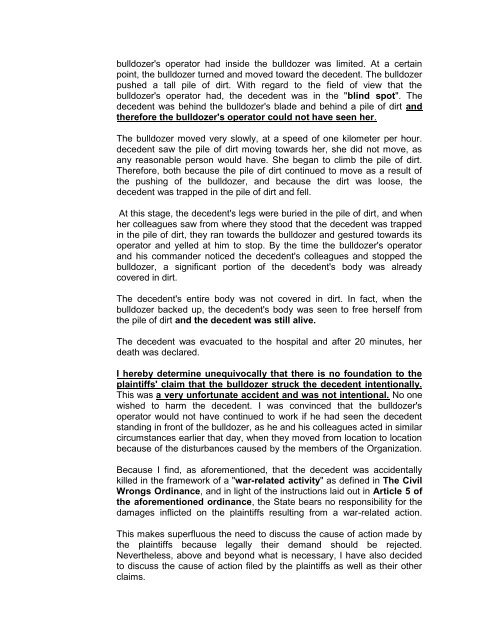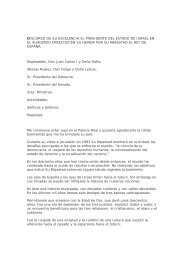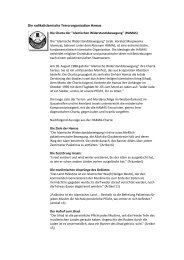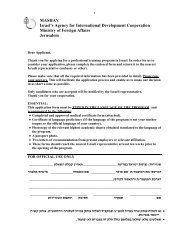Summary of the Verdict (TA 371/05) Estate of the Late Rachel Corrie ...
Summary of the Verdict (TA 371/05) Estate of the Late Rachel Corrie ...
Summary of the Verdict (TA 371/05) Estate of the Late Rachel Corrie ...
You also want an ePaper? Increase the reach of your titles
YUMPU automatically turns print PDFs into web optimized ePapers that Google loves.
ulldozer's operator had inside <strong>the</strong> bulldozer was limited. At a certain<br />
point, <strong>the</strong> bulldozer turned and moved toward <strong>the</strong> decedent. The bulldozer<br />
pushed a tall pile <strong>of</strong> dirt. With regard to <strong>the</strong> field <strong>of</strong> view that <strong>the</strong><br />
bulldozer's operator had, <strong>the</strong> decedent was in <strong>the</strong> "blind spot". The<br />
decedent was behind <strong>the</strong> bulldozer's blade and behind a pile <strong>of</strong> dirt and<br />
<strong>the</strong>refore <strong>the</strong> bulldozer's operator could not have seen her.<br />
The bulldozer moved very slowly, at a speed <strong>of</strong> one kilometer per hour.<br />
decedent saw <strong>the</strong> pile <strong>of</strong> dirt moving towards her, she did not move, as<br />
any reasonable person would have. She began to climb <strong>the</strong> pile <strong>of</strong> dirt.<br />
Therefore, both because <strong>the</strong> pile <strong>of</strong> dirt continued to move as a result <strong>of</strong><br />
<strong>the</strong> pushing <strong>of</strong> <strong>the</strong> bulldozer, and because <strong>the</strong> dirt was loose, <strong>the</strong><br />
decedent was trapped in <strong>the</strong> pile <strong>of</strong> dirt and fell.<br />
At this stage, <strong>the</strong> decedent's legs were buried in <strong>the</strong> pile <strong>of</strong> dirt, and when<br />
her colleagues saw from where <strong>the</strong>y stood that <strong>the</strong> decedent was trapped<br />
in <strong>the</strong> pile <strong>of</strong> dirt, <strong>the</strong>y ran towards <strong>the</strong> bulldozer and gestured towards its<br />
operator and yelled at him to stop. By <strong>the</strong> time <strong>the</strong> bulldozer's operator<br />
and his commander noticed <strong>the</strong> decedent's colleagues and stopped <strong>the</strong><br />
bulldozer, a significant portion <strong>of</strong> <strong>the</strong> decedent's body was already<br />
covered in dirt.<br />
The decedent's entire body was not covered in dirt. In fact, when <strong>the</strong><br />
bulldozer backed up, <strong>the</strong> decedent's body was seen to free herself from<br />
<strong>the</strong> pile <strong>of</strong> dirt and <strong>the</strong> decedent was still alive.<br />
The decedent was evacuated to <strong>the</strong> hospital and after 20 minutes, her<br />
death was declared.<br />
I hereby determine unequivocally that <strong>the</strong>re is no foundation to <strong>the</strong><br />
plaintiffs' claim that <strong>the</strong> bulldozer struck <strong>the</strong> decedent intentionally.<br />
This was a very unfortunate accident and was not intentional. No one<br />
wished to harm <strong>the</strong> decedent. I was convinced that <strong>the</strong> bulldozer's<br />
operator would not have continued to work if he had seen <strong>the</strong> decedent<br />
standing in front <strong>of</strong> <strong>the</strong> bulldozer, as he and his colleagues acted in similar<br />
circumstances earlier that day, when <strong>the</strong>y moved from location to location<br />
because <strong>of</strong> <strong>the</strong> disturbances caused by <strong>the</strong> members <strong>of</strong> <strong>the</strong> Organization.<br />
Because I find, as aforementioned, that <strong>the</strong> decedent was accidentally<br />
killed in <strong>the</strong> framework <strong>of</strong> a "war-related activity" as defined in The Civil<br />
Wrongs Ordinance, and in light <strong>of</strong> <strong>the</strong> instructions laid out in Article 5 <strong>of</strong><br />
<strong>the</strong> aforementioned ordinance, <strong>the</strong> State bears no responsibility for <strong>the</strong><br />
damages inflicted on <strong>the</strong> plaintiffs resulting from a war-related action.<br />
This makes superfluous <strong>the</strong> need to discuss <strong>the</strong> cause <strong>of</strong> action made by<br />
<strong>the</strong> plaintiffs because legally <strong>the</strong>ir demand should be rejected.<br />
Never<strong>the</strong>less, above and beyond what is necessary, I have also decided<br />
to discuss <strong>the</strong> cause <strong>of</strong> action filed by <strong>the</strong> plaintiffs as well as <strong>the</strong>ir o<strong>the</strong>r<br />
claims.
















